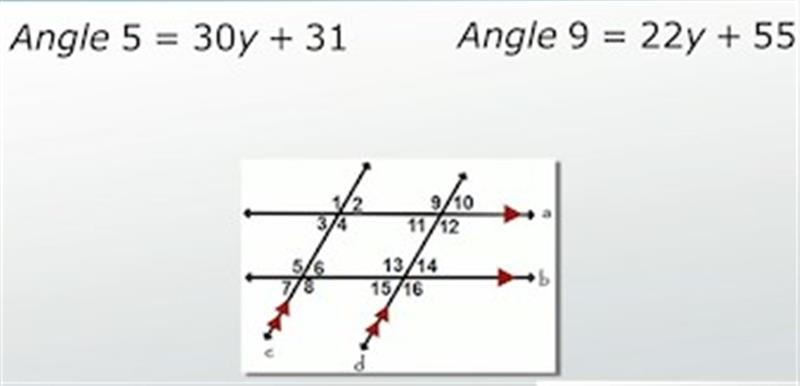Solving Angles
In another lesson, we learned about the different types of angles: consecutive interior, alternate interior, alternate exterior and corresponding. We discovered that when two lines are parallel, all of the angle pairs are congruent, except for consecutive interior angles, which are supplementary. We also learned about vertical angles, which are always congruent. Let's do some practice with these angles.
In the figure below, let Angle 5 = 30y + 31, and let Angle 9 = 22y + 55. What is the value of y?
kkk


Example figure for solving angle problems
Angle 5 and Angle 9 don't match any of the angle pairs, so let's find the connection between their measures. We notice that Angle 5 corresponds to Angle 1, and Angle 1 corresponds to Angle 9. Knowing that all corresponding angles are congruent, Angle 5= Angle 1, and Angle 1 = Angle 9. So, by the transitive property of equality, we can conclude that Angle 5 = Angle 9. By substituting the equations, we have 30y + 31 = 22y + 55. From here, we can subtract 31 from both sides to get 30y = 22y + 24, and then subtract 22y from each side to get 8y = 24. To finish, we will divide both sides by 8 to determine that y = 3.
Let's do another using the same figure. This time, let Angle 4 = 14x - 23, and let Angle 14 = 4x + 5. Find the measure of Angle 15.
Once again, these angles are not a special angle pair; so, let's find the connection. Angle 4 corresponds to Angle 12, and Angle 12 is consecutive interior to Angle 14. Therefore, Angle 4 = Angle 12, and Angle 12 + Angle 14 = 180. With this knowledge, we can replace Angle 12 with Angle 4 to get Angle 4 + Angle 14 = 180. With the equations, we have 14x - 23 + 4x + 5 = 180. Combining like terms gives us 18x - 18 = 180, and then, by adding 18 to both sides, we get 18x = 198. Last, we will divide both sides by 18 to conclude that x = 11.
Now we can find the value of Angle 15, which is vertical to and congruent with Angle 14. Substituting 11 into the equation, we see that Angle 14 = 4(11) + 5, which equals 49. Therefore, we can also conclude that Angle 15 = 49 degrees.